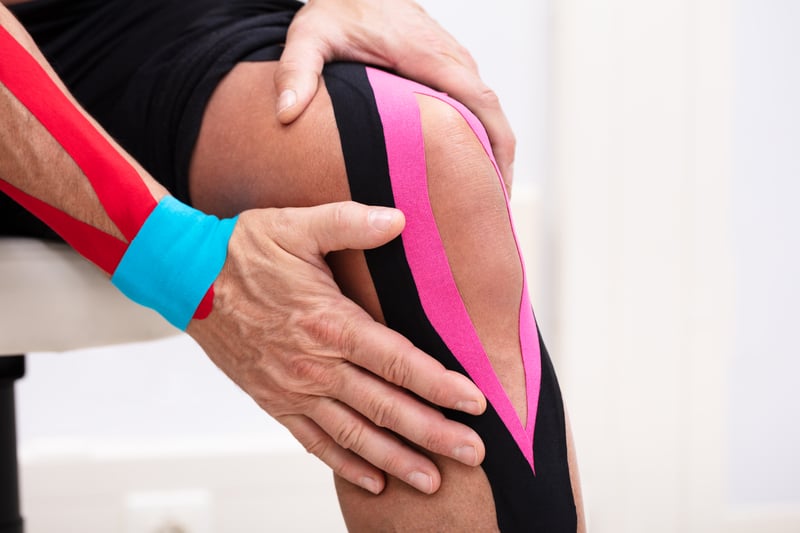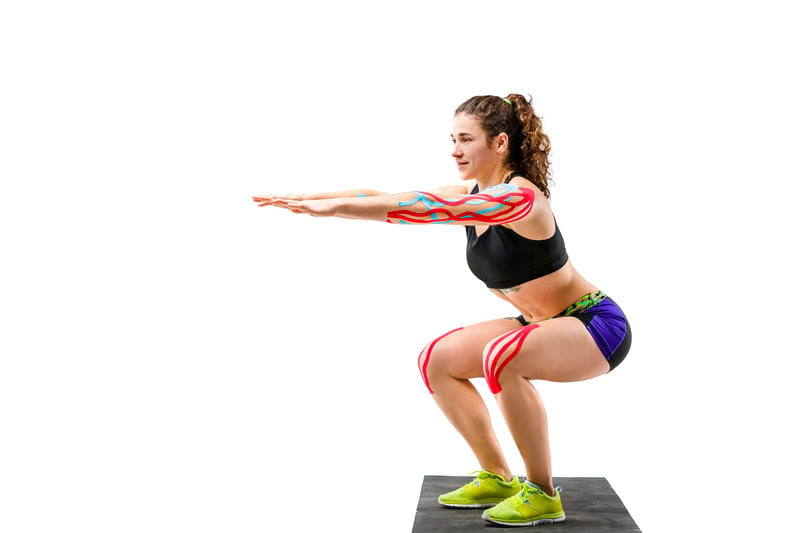From Pain Relief to Performance Boost: How Kinesiology Tape Works

Have you always wondered what that tape is that you see athletes wearing? It’s in an array of colors, looks strategically placed, and often looks like it’s holding together shoulders, knees, or other vulnerable joints. Learn how kinesiology tape works and how it can help you in many ways, including providing an athletic performance boost, helping align joints, and potentially relieving pain in everyday life.
What Is Kinesiology Tape?
Kinesiology tape is an elastic therapeutic tape used in sports and for rehab to help reduce pain and impairment from injury. It’s also widely used in sports to help bolster athletic functioning. You’ll often see these strips of tape, in various colors and patterns, taped on athletes’ bodies to help them through their movements.
Originally called “Kinesio Tex Tape,” it was developed by Japanese chiropractor Dr. Kenzo Kase and was first widely used in the 1970s. Dr. Kase wanted something that would help support muscles, joints, and tendons without hampering movement or performance. Up until this time, the only type of tape used for injuries was regular non-elastic rehab adhesive. That type of tape offers no give and tends to be used to prevent the muscles and joints from moving. Kinesiology tape, on the other hand, promotes movement in the correct patterns, allowing for flexibility while supporting the injured areas.
Having a working knowledge of anatomy is also essential for the proper placement of the tape. How kinesiology tape works is by lining up the tape with the painful areas, usually where ligaments and joints connect, and then placing the tape to assist and strengthen the area and act as a “second skin,” supporting what’s underneath but allowing for plenty of movement.
Benefits of Kinesiology Tape
While the kaleidoscope of colors and patterns may look cool on the body, the true magic lies in how kinesiology tape works and the many benefits it offers for both athletes and non-athletes. There are four main categories when it comes to how kinesiology tape works:
- Supports muscles
- Helps correct joint problems
- Helps activate your natural pain relief system
- Shuttles fluids
But the benefits are even more robust than just those four categories. Additional benefits of taping can include:
Relieving pain at trigger points—placing the kinesiology tape so it gently lifts the tissue above trigger points can help minimize pain and pressure on the areas.
Improving circulation—using kinesiology tape can help improve lymph node drainage and increase circulation by creating space between the skin and the injured area, allowing for better blood flow.
Reducing inflammation—proper taping can also help temper inflammation and move excess fluids away from the area.
Getting rid of toxins—the increased circulation and shuttling of excess fluids away from the injured area also helps get rid of toxins that may build up around the injury.
Helping create space between joints—the tape can also be placed to help gently create space between the joints. While it clearly doesn’t make a large difference in the area between joints space-wise, the small improvement may help mitigate pain and irritation surprisingly well.
Supporting weak areas—you’ll often see areas like knees and shoulders, IT bands, Achilles tendons, and other weak or injured body parts taped up. Without inhibiting movement, the kinesiology tape provides a gentle brace and support to assist functionality.
Helping minimize swelling in the area—the proper placement of the tape can also help remove fluids from the affected area and reduce swelling.
Providing muscle support—the added support of the tape provides muscles with much-needed reinforcement and can help take some stress off tendons and ligaments, allowing you to move more freely.
Correcting joint problems—often, you’ll feel pain when your joints aren’t tracking properly. Taping the right way can really help! Your joints, muscles, and ligaments will learn new paths of movement as you use the area and the tape on a regular basis.

When Should You Stay Away from Kinesiology Tape?
If you’re dealing with open wounds or sores, sensitive skin, or an allergy to adhesives, you may want to skip the taping. In addition, those suffering from cancer, diabetes, or blood clots should avoid using kinesiology tape as the increased flow of fluid could be dangerous.
Yes, you can go online to find out more about using kinesiology tape on yourself, but beware. Just because you know how kinesiology tape works doesn’t mean you should slap some on any old place where you feel pain. Typically, a medical practitioner will help determine the proper placement of the tape, depending on your pain, injuries, and goals with treatment.





